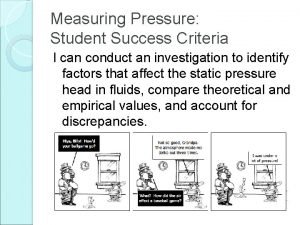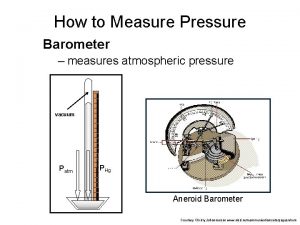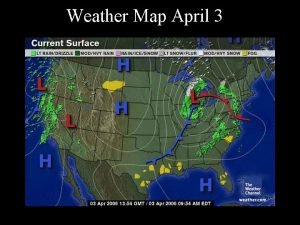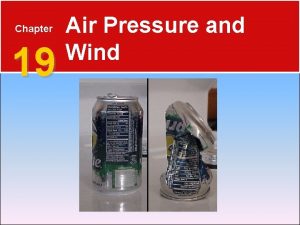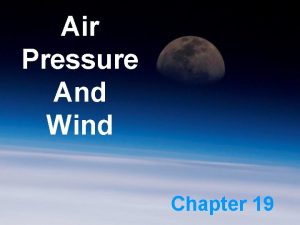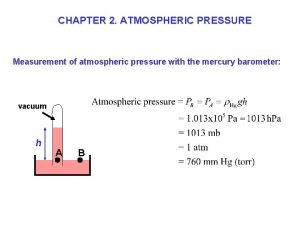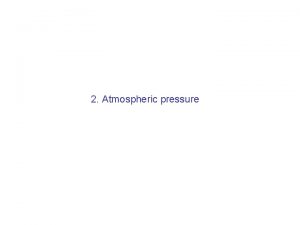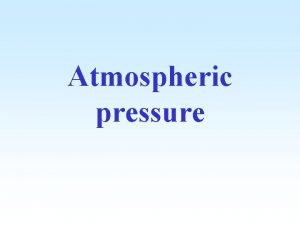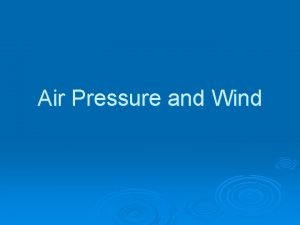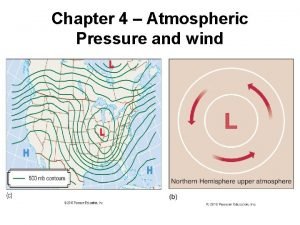Lecture 11 Atmospheric Pressure Intro to Wind Understanding











- Slides: 11

Lecture 11 Atmospheric Pressure & Intro to Wind

Understanding Pressure • AIR PRESSURE –is the pressure exerted by the weight of the air above. • Is DEFINED as: –The FORCE exerted against a surface by the continuous collision of gas molecules

Measuring Air Pressure • Unit: Newton (N) • At Sea Level one “atmosphere” exerts – 14. 7 pounds per square inch – 101, 325 N per square m (N/m 2) • Meteorologist use millibars (mb) – 1 mb = 100 N/m 2 – Standard Sea Level Pressure • ~ 1013. 25 mb* * This is a number you MUST memorize!!!!

Measuring Air Pressure • Besides mb we use “inches of mercury” or inches of Hg. – 29. 92 in. Hg. • Barometer –instrument to measure pressure –Filled with liquid mercury

Measuring Air Pressure • Aneroid barometer –No fluid –Aneroid cell –Have at home • Barograph –An aneroid barometer that records a trace of the pressure as time passes

Pressure and Wind 1. Horizontal differences in pressure causes winds 3. Horizontal differences in pressure are caused by differences in heating 5. Winds flow from regions of high pressure to regions of low pressure 7. Horizontal differences in P lead to the PRESSURE GRADIENT FORCE

Influence of Temp and Water Vapor • (A) Warm Air –Fast moving molecules –Typically less dense –LOW PRESSURE • (B) Cold Air –Slow moving molecules –Typically more dense –HIGH PRESSURE **Factors other then Temp can affect Pressure… you can have “warm” high pressure

Influence of Temp and Water Vapor HIGH PRESSURE • SUMMARY –Cold, dry air masses produce High Surface Pressures –Cold, humid air masses are less “high” than cold, dry –Warm, dry air masses are less “low” than warm, humid LOW PRESSURE –Warm, humid air masses produce Low Surface Pressures

ISOBARS • Contours (lines or curves) of constant PRESSURE l. Just like your isotherms for temperature l. They are corrected for altitude to equivalent Sea Level Pressure (SLP)

ISOBARS – Let’s do an example! L L H H

What is Wind? • Wind is nature’s attempt at balancing inequalities in pressure • FACT: –Unequal heating of the Earth’s surface generates these inequalities. • FACT: –Solar radiation is the ultimate source of energy for Wind
 Atmospheric physics lecture notes
Atmospheric physics lecture notes Lightning elves
Lightning elves Air pressure at different altitudes
Air pressure at different altitudes Pressure head meaning
Pressure head meaning Sea level barometer
Sea level barometer Low atmospheric pressure
Low atmospheric pressure Atmospheric pressure in complete denture
Atmospheric pressure in complete denture Usairnet temperature map
Usairnet temperature map 01:640:244 lecture notes - lecture 15: plat, idah, farad
01:640:244 lecture notes - lecture 15: plat, idah, farad Steuerbord vor backbord
Steuerbord vor backbord Winds are labeled according to
Winds are labeled according to Chapter 19 air pressure and wind
Chapter 19 air pressure and wind



